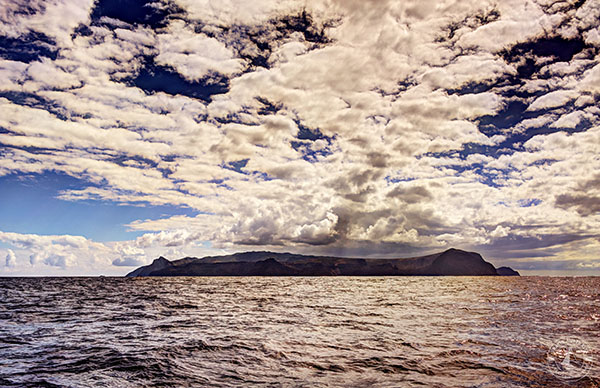St Helena, created more than fourteen million years ago by volcanic eruptions, was in sight upon the horizon soon after the passing of dawn. The island, inch by inch, became more pronounced as each hour passed.
The highest peak of an ancient volcanic mountain range, she was enshrouded by the misty haze of the tropical airs and bright backlight of the moving sun. As the day progressed, ebony black cumulus built and draped above the island, encapsulating it like a long flowing drape as tears of water rained down: dark and foreboding was her appearance as Gratis edged ever closer. Evening approached and her work completed, upon an evening breeze the grey veil drifted westward over the horizon, swept still shedding water.
Stark denuded perpendicular black cliff faces, exposed to the elements over the millennia fell to the sea. One could only imagine the stark horror that overtook Napoleon upon his first sighting of this barren landscape from the ship as it approached the shoreline.
Late afternoon upon us, we were at long last close enough that details were visible to the eye.
It was now possible to espy an amalgam of red and white earths sandwiched between the rugged layers of what had once been molten rock. It was virtually inconceivable that life could be found upon shorelines such as these.
Closer yet, pastures of vibrant green carpet swathed the cliff faces, meeting the sea at the base of a valley that may have once been filled by glacial ice.
Birds fished and soared, whilst a pod of dolphins raced and leapt in abandon through the swells as they continued on their way out to sea.
Waters surrounding the island: so, so deep that the depth didn’t register upon the sounder until one was practically upon the cliff face. In the lee of the land, Gratis motored beneath the giant, only metres from shore, whilst we viewed the monolith in awe.
Amazingly, thanks to the birds and with the assistance of rains, trees had taken on life as they managed to gain a foothold in cracks and crevices upon the sides. Long-running tendrils of creepers dangled as a river in their endeavour to reach the sea below, whilst white flecks that were the minuscule birds flitted here and there.
As late afternoon commenced rolling into evening we at last turned the final corner and pointed our girl’s bow toward what would be our anchorage for the next few days.
The camouflaged crumbling remains of an old fort constructed from the island’s stone was, like a marble cake, layered in tiers upon head land, whilst the sea undermined and created tunnels in the rock below.
One day, in the far distant future these remains will launch upon their final journey into the waters below and commence a return to dust.
Like a shining white sheet upon the hill face, the township of Jamestown spread, whilst a multitude of watercraft lay attached to moorings laid in long lines emanating from the shore. With depths rapidly plummeting to 30+ meters, holding poor, anchoring along the shore here was not wise. With this in mind the authorities laid multiple moorings upon which cruising yachts could reside, leaving their owners safe in the knowledge that their homes would not come to undue harm.
The story was told by locals of a recent visitor, who unhappy with the rolling swells – yes, they were uncomfortable – in favour of a good night’s sleep made the decision to anchor beneath the cliff face. Heading ashore the following morning, he was fortunate when an observant local took note of his boat ‘walking’, and thereby set about replacing it to a mooring. Dotted throughout the harbour were a myriad of wrecks. In some cases, their bows just visible above the waterline, they were the result of dragging anchors in the days before moorings.
Attaching the line upon the mooring was an adventure in itself. A large yellow disc with a metal hoop jutting out from the centre. Having read there was no line attached for the sailor to grab hold of and drag aboard, Bob fashioned a hook that was designed to grab hold of the loop. Having decided upon our position, Gratis made her approach. Beautifully aligned, over went the hook, the aim to connect. His time and effort wasted, the hoop was way too thick for the snap shackle. A quick Plan B came to the fore. Whilst Bob prepared a new mooring line, I manoeuvred Big G into position once more. Leaning over the side, Bob attempted to thread the line through that wretched hoop: no luck, as Gratis drifted off. A second, third, and fourth time, growing ever more frustrated with each passing moment, we continued unsuccessfully. The time for Plan C arrived. I, as before, motored Gratis into position. Using our long grappling hook, Bob grabbed hold of the hoop and hung on. Gratis in neutral, I raced out grabbed the line, leaned over, threaded it through the connection, and brought it back on board. Breathing a sigh of relief, all that remained doing was the creation of a bridle which connected Big G to the mooring and shutting down the engine.













